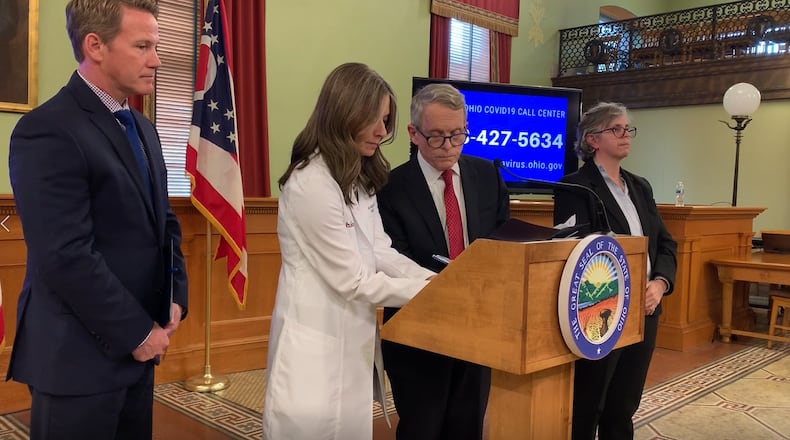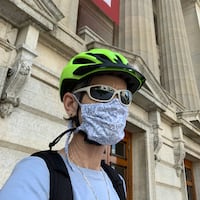>> Coronavirus: Complete Coverage
Here is a timeline of the announcement and orders that have changed life in Ohio:
• Jan. 23: The Ohio Department of Health makes coronavirus a mandatory reportable disease in Ohio.
• March 5: Gov. DeWine and Columbus Mayor Andrew Ginther announce Arnold Sports Festival closed to spectators and limited to athletes and parents of athletes
• March 6: ODH launches a call center (1-833-4-ASK-ODH) to answer questions about COVID-19.
• March 9: Gov. DeWine declares a State of Emergency after three people test positive for coronavirus in Ohio.
• March 10: Ohio Secretary of State Frank LaRose orders more than 100 polling locations at senior centers to be moved. Gov. DeWine and Acton ask colleges and universities to move toward online learning and for indoor sporting events to ban spectators. They also stop visits at prisons.
• March 11: Ohio's fourth case of coronavirus is confirmed. Gov. DeWine limits nursing home visits to one person per patient per day. The governor also discusses plans for restrictions at public events. The World Health Organization declares COVID-19 a global pandemic.
• March 12: The fifth case of coronavirus is confirmed in Ohio. Gov. DeWine and Acton order K-12 schools to shut down from March 17 to April 6, prohibit mass gatherings of more than 100 people and ban visitors at nursing homes and state psychiatric hospitals.
• March 13: Ohio has 13 confirmed cases of coronavirus. Gov. DeWine bans visitors at county jails and corrections centers.
• March 15: There are 37 confirmed cases of coronavirus in Ohio. Gov. DeWine and Acton order all bars and restaurants to close dining rooms, but carry-out and delivery services can continue.
• March 16: Fifty cases of coronavirus confirmed in Ohio. Gov. DeWine asks for Ohio's election to be extended to June 2. Gov. DeWine and Acton order bowling alleys, movie theaters, indoor water parks, indoor trampoline parks, fitness centers, gyms and recreation centers to close. Acton issues a public order in the evening closing Ohio's polling locations. Public gatherings are limited to 50 people.
• March 17: Gov. DeWine and announces an Ohio Department of Health order declaring elective surgeries and procedures in hospitals be delayed to preserved personal protective equipment for healthcare workers. The governor also signed an executive order allowing Ohio Department of Job and Family Services to provide child care to families with parents who work in health, safety and essential service fields during the pandemic.
• March 18: Gov. DeWine orders the closure of barbershops, beauty salons, tattoo parlors and hair and nail salons. More than 180 Bureau of Motor Vehicles registrar offices are also closed in the state. The governor asks that law enforcement not ticket people who were unable to renew their license due to the registrar closures. Gov. DeWine also asks businesses that are still open to take the temperature of every employee every day prior to work.
• March 19: Gov. DeWine announces an executive order that expands telehealth options for Medicaid recipients. The order allows Ohioans to access medical care remotely, reducing the risk of coronavirus exposure.
• March 20: The first coronavirus death in Ohio is confirmed. The man, Mark Wagoner Sr., was a Toledo attorney. Gov. DeWine announces an executive order that will close facilities providing older adult daycare services and senior centers. The order will go into effected at the close of business March 23. Lt. Gov. Jon Husted announces an order from the Ohio Department of Insurance that allows employers to defer health insurance premium payments for up to two months.
• March 21: The state's second and third coronavirus deaths are confirmed. Gov. DeWine orders adult day support services for people with developmental disabilities with more than 10 people to close.
• March 22: Gov. DeWine and Acton announce a stay-at-home order. Under the order, Ohioans are to stay at home from March 24 to April 7, unless going to get medicine, medical care, groceries, necessary supplies and taking care of neighbors or family. People can also go outside to get exercise or go to work for essential businesses. Starting March 26, childcare centers must have a Temporary Pandemic Child Care license. Centers shouldn't have more than six kids per class and are to limit use of shared spaces and mixing groups. The license extends to April 30, with the option to extend and adjust.
• March 23: Six deaths reported in Ohio. Gov. DeWine orders a hiring freeze in state government and on state contracts unless essential to the coronvirus pandemic.
• March 30: The state's death toll increase to 39. Gov. DeWine and Acton extend an order that closes K-12 schools. The three-week order, which was set to expire April 6, is extended to May 1.
• March 31: Acton issues an order that tracks ventilators in Ohio. The order requires weekly online reporting of all ventilators, CPAP and BiPAP machines. Exemptions includes machines in an individual's possession for personal use and machines in transport across the state but are being delivered to other states.
• April 1: Sixty-five deaths are reporting in Ohio. Acton signs an order to get coronavirus test results back faster. All Ohio hospitals that do not conduct their own testing must send specimens to labs at Ohio State University Wexner Medical Center, Cleveland Clinic, University Hospitals in Cleveland and MetroHealth. Gov. DeWine also signs an executive order asking lenders and landlords to work with small business owners and suspend rent and mortgage payments for at least 90 days.
• April 2: Ohio's death toll increased to 81. At least 2,902 cases are confirmed. Acton signs an extension to the stay at home order. Originally scheduled to end April 8, the order is now ends May first at 11:59 p.m. Updates to the order include the creation of a dispute resolution process to help in situations where different health departments come to different decisions on whether or not a business is essential. It also requires businesses to set a maximum number of people allowed in the store at once and to enforce that limit.
• April 3: Gov. DeWine announces steps to release a few hundred state prisoners early. Under his guidelines, the inmates cannot be convicted of a violent or serious crime, have health complications that put them at risk for coronavirus or have less than 90 days left in their sentence.
• April 4: The state hit 102 deaths attributed to coronavirus. Gov. DeWine signs an executive order making it easier for Ohioans to get access to telehealth services. The order waives requirements that a patient must have had a face-to-face meeting before qualifying for a telehealth appointment.
• April 6: The Ohio National Guard is sent to assist a federal prison in eastern Ohio with a COVID-19 outbreak.
• April 7: The state reports 167 deaths connected to the pandemic. The Ohio Liquor Control Commission passes an emergency rule allowing establishments with an existing on-premise liquor license to sell and deliver alcohol, including high-proof liquor. Patrons cannot purchase more than two drinks per meal. All drinks must be in closed containers and remain closed while being transported. Breweries can sell beer and wine that is not their own without the purchase of a meal, but a food order is necessary to buy liquor.
• April 9: Protests begin at the Ohio Satehouse against the shutdown.
• April 13: There are 268 confirmed deaths from coronavirus. Gov. DeWine announces an order requiring long-term care facilities to notify residents and their families within 24 hours if any staff or residents test positive for the virus. A list of facilities that have positive cases will also be available here. The governor also issues an executive order providing $5 million in funding to Ohio foodbanks from the Temporary Assistance to Needy Families block grant. An additional $1 million is granted to the Coalition of Homelessness and Housing in Ohio to help shelters purchase cleaning supplies and provide housing services.
• April 14: Ohio reports 309 confirmed deaths. Acton announces an order providing the names and addresses of those who tested positive for the virus to emergency dispatchers to protect first responders. The information is only to be released to first responders. After a person has recovered from the virus, the information will be removed for the dispatch agency's system.
• April 27: Gov. Mike DeWine unveils plans to begin reopening Ohio starting May 1. The plan includes guidance and requirements for difference industries and businesses.
• April 29: Gov. DeWine issues guidelines on graduations and asks that people refrain from holding graduation parties. Virtual graduations are preferred, followed by a drive-in ceremony for each student to get his or her diploma at a designated time and place. The third option — the least preferred — would be to gather in groups of no more than 10 people.
• April 30: Gov. DeWine and Acton extend the state's stay-at-home order to May 29. Exceptions include businesses and industries that the governor scheduled to reopen throughout the month.
• May 1: Medical, dental and veterinarian officers are allowed to reopen. Elective surgeries that do not require an overnight hospital stay can resume.
• May 4: Construction, manufacturing and distribution companies can reopen.
• May 12: Retail and consumer businesses are allowed to reopen. Ohio is reporting 1,303 confirmed deaths.
RELATED CONTENT:
>> Coronavirus: When will you have to wear a mask in Ohio?
>> Caution urged as first business reopen in Ohio May 1
>> Local hospital to give new ‘game changing’ coronavirus drug
>> First in nation: Blood center, Premier using recovered patients’ plasma to fight COVID-19
>> Which Dayton-area restaurants are offering carryout, delivery and curbside service?
>> How Dayton-area people are coping with coronavirus: ‘We’re all trying to figure out the new reality’
>> Coronavirus: Foodbanks could serve 40 percent of Ohioans by time pandemic ends

